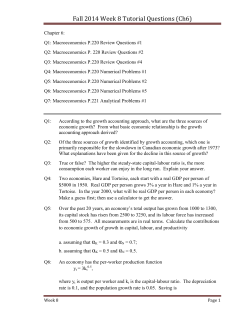
SAMPLE EXAM QUESTIONS FOR FALL 2013 ECON3310 MIDTERM 2 Contents PART I.
SAMPLE EXAM QUESTIONS FOR FALL 2013 ECON3310 MIDTERM 2 Contents: Chs 5, 6, 7, 8, 9, 11 and part of 12. PART I. Short questions: 4 out of 5 (40% of total marks) 1. Assume that in a small open economy where full employment always prevails, national saving is 300. a. If domestic investment is given by I = 400 – 20r, where r is the real interest rate in percent, what would the equilibrium interest rate be if the economy were closed? b. If the economy is open and the world interest rate is 10 percent, what will investment be? c. What will the current account surplus or deficit be? What will net capital outflow be? 2. The economies of two countries, Thrifty and Profligate, have the same production functions and depreciation rates. There is no population growth or technological progress in either country. The economies of each country can be described by the Solow growth model. The saving rate in Thrifty is 0.3. The saving rate in Profligate is 0.05. a. In which country is the level of steady-state output per worker larger? Explain. b. In which country is the steady-state growth rate of output per worker larger? Explain. c. In which country is the growth rate of steady-state total output greater? Explain. 3. Assume the following model of the economy, with the price level fixed at 1.0: C = 0.8(Y – T) T = 1,000 I = 800 – 20r G = 1,000 Y=C+I+G Ms/P = Md/P = 0.4Y – 40r Ms = 1,200 a. Write a numerical formula for the IS curve, showing Y as a function of r alone. (Hint: Substitute out C, I, G, and T.) b. Write a numerical formula for the LM curve, showing Y as a function of r alone. (Hint: Substitute out M/P.) c. What are the short-run equilibrium values of Y, r, Y – T, C, I, private saving, public saving, and national saving? Check by ensuring that C + I + G = Y and national saving equals I. d. Assume that G increases by 200. By how much will Y increase in short-run equilibrium? What is the government-purchases multiplier (the change in Y divided by the change in G)? Page 1 PART II. Multiple choice questions: 30 questions with no choice (60% of total marks) 1. The quantity theory of money assumes that: A) income is constant. B) velocity is constant. C) prices are constant. D) the money supply is constant. 2. The right of seigniorage is the right to: A) levy taxes on the public. B) borrow money from the public. C) draft citizens into the armed forces. D) print money. 3. In a small, open economy if net exports are negative, then: A) domestic spending is greater than output. B) saving is greater than investment. C) net capital outflows are positive. D) imports are less than exports. 4. In a small open economy with perfect capital mobility, the real interest rate will always be: A) above the world real interest rate. B) below the world real interest rate. C) equal to the world real interest rate. D) equal to the world nominal interest rate. 5. If the real exchange rate is high, foreign goods: A) and domestic goods are both relatively expensive. B) and domestic goods are both relatively cheap. C) are relatively expensive and domestic goods are relatively cheap. D) are relatively cheap and domestic goods are relatively expensive. 6. Any policy aimed at lowering the natural rate of unemployment must either ______ the rate of job separation or ______ the rate of job finding. A) reduce; reduce B) increase; increase C) reduce; increase D) increase; reduce Page 2 7. The change in capital stock per worker (k) may be expressed as a function of s = the saving ratio, f(k) = output per worker, k = capital per worker, and = the depreciation rate, by the equation: A) k = sf(k)/k. B) k = sf(k) × k. C) k = sf(k) + k. D) k = sf(k) – k. 8. Exhibit: Output, Consumption, and Investment In this graph, when the capital–labor ratio is OA, AB represents: A) investment per worker, and AC represents consumption per worker. B) consumption per worker, and AC represents investment per worker. C) investment per worker, and BC represents consumption per worker. D) consumption per worker, and BC represents investment per worker. 9. In the two-sector endogenous growth model, the fraction of labor in universities (u) affects the steady-state: A) level of income. B) growth rate of income. C) level of income and growth rate of income. D) level of income, growth rate of income, and growth rate of the stock of knowledge. Page 3 Use the following to answer question 10: Exhibit: Keynesian Cross 10. (Exhibit: Keynesian Cross) In this graph, if firms are producing at level Y3, then inventories will ______, inducing firms to ______ production. A) rise; increase B) rise; decrease C) fall; increase D) fall; decrease 11. The IS curve shifts when any of the following economic variables change except: A) the interest rate. B) government spending. C) tax rates. D) the marginal propensity to consume. 12. The reason that the income response to a fiscal expansion is generally less in the IS–LM model than it is in the Keynesian-cross model is that the Keynesian-cross model assumes that: A) investment is not affected by the interest rate whereas in the IS–LM model fiscal expansion raises the interest rate and crowds out investment. B) investment is not affected by the interest rate whereas in the IS–LM model fiscal expansion lowers the interest rate and crowds out investment. C) investment is autonomous whereas in the IS–LM model fiscal expansion encourages higher investment, which raises the interest rate. D) the price level is fixed whereas in the IS–LM model it is allowed to vary. Page 4 Answer Key 1. a. b. c. 2. a. b. c. 3. a. b. c. d. 1. 2. 3. 4. 5. 6. 7. 8. 9. 10. 11. 12. 5 percent 200 The trade surplus will be 100. Thrifty will have the higher level of steady-state output per worker. With a higher saving rate in Thrifty, there will be more saving, more investment, and, consequently, a higher steady-state capital per worker ratio. For the same production function, the higher capital per worker ratio will produce a higher level of steady-state output per worker. In the steady state in both countries, capital per worker is constant, so output per worker is constant. The growth rate of output per worker is zero in both Thrifty and Profligate. Since there is no population growth or technological change in the steady state, total output will be constant in both countries. The growth rate of total output will be zero in both Thrifty and Profligate. Y = 5,000 – 100r. Y = 3,000 + 100r. In the short-run equilibrium, Y = 4,000; r = 10; Y – T = 3,000; C = 2,400; I = 600; private saving is 600; public saving is 0; and national saving is 600. Y increases by 500. The government spending multiplier is 2.5. B D A C D C D C D B A A Page 5
© Copyright 2025


















